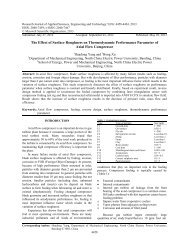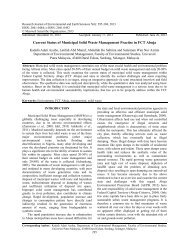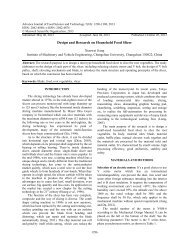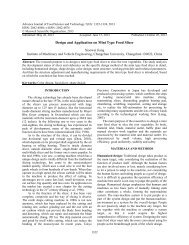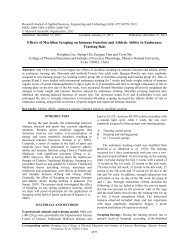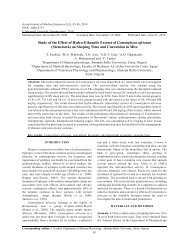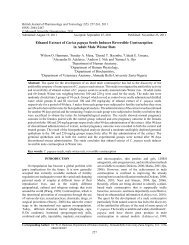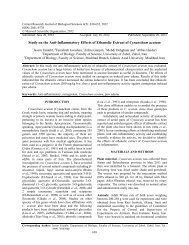Effect of Sowing Date on the Incidence, Apparent ... - Maxwell Science
Effect of Sowing Date on the Incidence, Apparent ... - Maxwell Science
Effect of Sowing Date on the Incidence, Apparent ... - Maxwell Science
Create successful ePaper yourself
Turn your PDF publications into a flip-book with our unique Google optimized e-Paper software.
Asian Journal <str<strong>on</strong>g>of</str<strong>on</strong>g> Agricultural <strong>Science</strong>s 2(2): 63-68, 2010<br />
ISSN: 2041-3890<br />
© <strong>Maxwell</strong> Scientific Organizati<strong>on</strong>, 2010<br />
Submitted <str<strong>on</strong>g>Date</str<strong>on</strong>g>: February 02, 2010 Accepted <str<strong>on</strong>g>Date</str<strong>on</strong>g>: February 17, 2010 Published <str<strong>on</strong>g>Date</str<strong>on</strong>g>: April 10, 2010<br />
<str<strong>on</strong>g>Effect</str<strong>on</strong>g> <str<strong>on</strong>g>of</str<strong>on</strong>g> <str<strong>on</strong>g>Sowing</str<strong>on</strong>g> <str<strong>on</strong>g>Date</str<strong>on</strong>g> <strong>on</strong> <strong>the</strong> <strong>Incidence</strong>, <strong>Apparent</strong> Infecti<strong>on</strong> Rate<br />
and Severity <str<strong>on</strong>g>of</str<strong>on</strong>g> Scab <strong>on</strong> Cowpea<br />
1 G.A. Mb<strong>on</strong>g, 2 C.N. Akem, 3 O. Alabi, 4 A.M. Emechebe and 3 M.D. Alegbejo<br />
1 Department <str<strong>on</strong>g>of</str<strong>on</strong>g> Plant Biology, University <str<strong>on</strong>g>of</str<strong>on</strong>g> Dschang, B.P. 67, Dschang, Camero<strong>on</strong><br />
2 Horticulture and Forestry <strong>Science</strong>, Department <str<strong>on</strong>g>of</str<strong>on</strong>g> Primary Industries and Fisheries,<br />
P.O. Box 15, Ayr, Queensland 4807, Australia<br />
3 Department <str<strong>on</strong>g>of</str<strong>on</strong>g> Crop Protecti<strong>on</strong>, Institute for Agricultural Research, Ahmadu Bello University,<br />
Samaru, PMB 1044, Zaria, Nigeria<br />
4 Internati<strong>on</strong>al Institute <str<strong>on</strong>g>of</str<strong>on</strong>g> Tropical Agriculture, Kano, Nigeria<br />
Abstract: The main aim <str<strong>on</strong>g>of</str<strong>on</strong>g> this study was to investigate <strong>the</strong> effect <str<strong>on</strong>g>of</str<strong>on</strong>g> sowing dates <strong>on</strong> <strong>the</strong> incidences, apparent<br />
infecti<strong>on</strong> rates and severities <str<strong>on</strong>g>of</str<strong>on</strong>g> cowpea scab, caused by Sphaceloma sp. <strong>on</strong> three varieties <str<strong>on</strong>g>of</str<strong>on</strong>g> cowpea<br />
(Vigna unguilata L. Walp). The varieties were: TVx 3236, SAMPEA-6 and IT93K452-1. The investigati<strong>on</strong>s<br />
were undertaken during <strong>the</strong> 2004, 2005 and 2006 cropping seas<strong>on</strong>s at Samaru and Shika in Zaria, Nigeria. Four<br />
sowings were d<strong>on</strong>e at 7-day interval starting from late July and ending in mid August <str<strong>on</strong>g>of</str<strong>on</strong>g> each year. Scab disease<br />
incidence and severity ratings were taken every seven days starting from <strong>the</strong> first visible symptoms <str<strong>on</strong>g>of</str<strong>on</strong>g> infecti<strong>on</strong><br />
<strong>on</strong> <strong>the</strong> plant parts. The design used was a factorial c<strong>on</strong>cept in a Randomized Complete Block Design (RCBD)<br />
with three replicati<strong>on</strong>s c<strong>on</strong>sisting <str<strong>on</strong>g>of</str<strong>on</strong>g> single row plots, each 75 cm wide, 6 m l<strong>on</strong>g, and 75 cm apart. For all <strong>the</strong><br />
3 seas<strong>on</strong>s, <strong>the</strong> early sown cowpeas had higher scab incidences, apparent infecti<strong>on</strong> rates and severities than <strong>the</strong><br />
late sown crops, even though not significantly higher in all cases or parameters. No scab symptoms were<br />
observed <strong>on</strong> <strong>the</strong> leaves <str<strong>on</strong>g>of</str<strong>on</strong>g> <strong>the</strong> more resistant cultivar, TVx 3236, in all 3 years <str<strong>on</strong>g>of</str<strong>on</strong>g> <strong>the</strong> investigati<strong>on</strong>. Under<br />
nor<strong>the</strong>rn Nigerian c<strong>on</strong>diti<strong>on</strong>s, early cowpea plantings would result in higher infecti<strong>on</strong>s from scab, unless more<br />
resistant cultivars are used in such early plantings.<br />
Key words: <strong>Apparent</strong> infecti<strong>on</strong> rate, cowpea, incidence, scab severity, sowing date, Sphaceloma<br />
INTRODUCTION<br />
Cowpea (Vigna unguiculata L. Walp (Fabaceae) is<br />
<strong>the</strong> most widely cultivated food legume in <strong>the</strong> nor<strong>the</strong>rn<br />
savanna states <str<strong>on</strong>g>of</str<strong>on</strong>g> Nigeria where rainfall is generally<br />
scanty and soils are sandy and relatively infertile. It is a<br />
cheaper source <str<strong>on</strong>g>of</str<strong>on</strong>g> protein than meat for <strong>the</strong> rural and<br />
urban poor in most developing countries (Henriet et al.,<br />
1997; Ogbuinya, 1997; Fawole et al., 2006). The crop is<br />
highly valued for both its grain and forage and<br />
<strong>the</strong>refore <str<strong>on</strong>g>of</str<strong>on</strong>g>ten has a dual use (Henriet et al., 1997;<br />
Ogbuinya, 1997).<br />
The major c<strong>on</strong>straints to cowpea producti<strong>on</strong> in<br />
Nigeria are pests and diseases. Scab, caused by <strong>the</strong> fungus<br />
Sphaceloma sp. is <strong>on</strong>e <str<strong>on</strong>g>of</str<strong>on</strong>g> <strong>the</strong> most destructive diseases <str<strong>on</strong>g>of</str<strong>on</strong>g><br />
cowpea in Nigeria and could account for more than 30%<br />
<str<strong>on</strong>g>of</str<strong>on</strong>g> <strong>the</strong> country’s total cowpea crop producti<strong>on</strong> losses<br />
(Mungo, 1996). Scab is a seed-borne disease, and affects<br />
all <strong>the</strong> above ground parts <str<strong>on</strong>g>of</str<strong>on</strong>g> <strong>the</strong> plant- leaves,<br />
petioles, stems, peduncles and pods (Emechebe, 1980;<br />
Iceduna, 1993). Lesi<strong>on</strong>s <strong>on</strong> stems <str<strong>on</strong>g>of</str<strong>on</strong>g>ten coalesce and<br />
cover <strong>the</strong> entire stem while those <strong>on</strong> leaves <str<strong>on</strong>g>of</str<strong>on</strong>g>ten give rise<br />
Corresp<strong>on</strong>ding Author: Dr. Chrys N. Akem, Horticulture and Forestry <strong>Science</strong>, Department <str<strong>on</strong>g>of</str<strong>on</strong>g> Primary Industries and Fisheries,<br />
P.O. Box 15, Ayr, Queensland 4807, Australia.<br />
63<br />
to shot holes which may be c<strong>on</strong>fused with insect damage<br />
(Iceduna, 1993). Under severe infecti<strong>on</strong> c<strong>on</strong>diti<strong>on</strong>s, <strong>the</strong>se<br />
coalescing lesi<strong>on</strong>s, cause leaf distorti<strong>on</strong>, and in some<br />
cases flower bud aborti<strong>on</strong>s <strong>the</strong>reby reducing podding and<br />
causing malformati<strong>on</strong> <str<strong>on</strong>g>of</str<strong>on</strong>g> pods with almost no seed set.<br />
Yield losses <str<strong>on</strong>g>of</str<strong>on</strong>g> up to 80% and even total crop destructi<strong>on</strong><br />
under disease epiphytotic c<strong>on</strong>diti<strong>on</strong>s have been reported<br />
in Nigeria (Emechebe, 1980; Mungo et al., 1995).<br />
Subsistence farmers in developing countries,<br />
including those in Nigeria have very few opti<strong>on</strong>s for <strong>the</strong><br />
c<strong>on</strong>trol <str<strong>on</strong>g>of</str<strong>on</strong>g> cowpea diseases <strong>on</strong> <strong>the</strong>ir crops. The use <str<strong>on</strong>g>of</str<strong>on</strong>g><br />
fungicides is very limited because <str<strong>on</strong>g>of</str<strong>on</strong>g> <strong>the</strong> associated costs<br />
<str<strong>on</strong>g>of</str<strong>on</strong>g> <strong>the</strong>se chemicals as well as handling issues and safety<br />
c<strong>on</strong>cerns to <strong>the</strong> users and to <strong>the</strong> envir<strong>on</strong>ment. They<br />
<strong>the</strong>refore rely mainly <strong>on</strong> cultural practices as an important<br />
aspect for <strong>the</strong>ir disease c<strong>on</strong>trol. The practices used include<br />
crop rotati<strong>on</strong>s, intercropping and crop spacing (Adebitan<br />
and Ikotun, 1996). <str<strong>on</strong>g>Sowing</str<strong>on</strong>g> dates have been reported to<br />
reduce <strong>the</strong> effects <str<strong>on</strong>g>of</str<strong>on</strong>g> diseases such as anthracnose<br />
(Colletotrichum lindernuthianum), brown blotch<br />
(Collectrichum capsici), and web blight (Thanatephorus<br />
cucumeris) <strong>on</strong> cowpeas (Yayock et al., 1988). Limited
informati<strong>on</strong> is however, available <strong>on</strong> <strong>the</strong> effect <str<strong>on</strong>g>of</str<strong>on</strong>g> sowing<br />
dates <strong>on</strong> <strong>the</strong> incidence <str<strong>on</strong>g>of</str<strong>on</strong>g> scab <strong>on</strong> cowpea. The main<br />
objective <str<strong>on</strong>g>of</str<strong>on</strong>g> this study was <strong>the</strong>refore to investigate how<br />
<strong>the</strong> manipulati<strong>on</strong> <str<strong>on</strong>g>of</str<strong>on</strong>g> different sowing dates could identify<br />
suitable producti<strong>on</strong> periods in which <strong>the</strong> crop could be<br />
sown with less favourable c<strong>on</strong>diti<strong>on</strong>s for disease<br />
development during <strong>the</strong> producti<strong>on</strong> cycle.<br />
MATERIALS AND METHODS<br />
Field experiments were carried out during <strong>the</strong> wet<br />
seas<strong>on</strong>s <str<strong>on</strong>g>of</str<strong>on</strong>g> 2003/2004, 2004/2005 and 2005/2006 at <strong>the</strong><br />
Institute for Agricultural Research farms at Samaru and<br />
Shika (11º11N, 07º38E, 686m above <strong>the</strong> sea level) in<br />
Nigeria. These farms are located in a predominantly<br />
cowpea producti<strong>on</strong> district <str<strong>on</strong>g>of</str<strong>on</strong>g> nor<strong>the</strong>rn Nigeria and<br />
supplies most <str<strong>on</strong>g>of</str<strong>on</strong>g> <strong>the</strong> cowpea grain to <strong>the</strong> sou<strong>the</strong>rn<br />
markets. For all three seas<strong>on</strong>s, three varieties <str<strong>on</strong>g>of</str<strong>on</strong>g> cowpea<br />
(TVx3236, SAMPEA-6, IT93K452-1) selected <strong>on</strong> <strong>the</strong><br />
basis <str<strong>on</strong>g>of</str<strong>on</strong>g> <strong>the</strong>ir agr<strong>on</strong>omic characteristics and reacti<strong>on</strong>s to<br />
scab were used in <strong>the</strong> study. The variety TVx 3236 is<br />
moderately resistant, IT93K452-1 is moderately<br />
susceptible and SAMPEA-6 is susceptible to scab.<br />
Four sowing dates were staggered, 7-days apart<br />
starting from <strong>the</strong> last week <str<strong>on</strong>g>of</str<strong>on</strong>g> July in each year, when <strong>the</strong><br />
typical first seas<strong>on</strong>al rains set in, and ending during <strong>the</strong><br />
third week <str<strong>on</strong>g>of</str<strong>on</strong>g> August. The typical sowing period for<br />
cowpeas in <strong>the</strong>se districts ranges from start <str<strong>on</strong>g>of</str<strong>on</strong>g> July to end<br />
<str<strong>on</strong>g>of</str<strong>on</strong>g> September. The dates selected <strong>the</strong>refore fell within this<br />
period.<br />
The experiment was arranged in a Randomized<br />
Complete Block Design (RCBD), in three replicati<strong>on</strong>s.<br />
Each plot c<strong>on</strong>sisted <str<strong>on</strong>g>of</str<strong>on</strong>g> five rows <str<strong>on</strong>g>of</str<strong>on</strong>g> 75 cm width and 6m<br />
l<strong>on</strong>g with 75 cm gap between ridges. The plots were<br />
separated by border rows c<strong>on</strong>sisting <str<strong>on</strong>g>of</str<strong>on</strong>g> <strong>on</strong>e ridge al<strong>on</strong>g<br />
each <str<strong>on</strong>g>of</str<strong>on</strong>g> <strong>the</strong> plot length and 2 m al<strong>on</strong>g <strong>the</strong> width. Cowpea<br />
seeds were hand-sown at a depth <str<strong>on</strong>g>of</str<strong>on</strong>g> 3-5 cm and at <strong>the</strong> rate<br />
<str<strong>on</strong>g>of</str<strong>on</strong>g> two seeds per hole using a spacing <str<strong>on</strong>g>of</str<strong>on</strong>g> 25 cm between<br />
holes.<br />
Plots were hand-weeded and with <strong>the</strong> help <str<strong>on</strong>g>of</str<strong>on</strong>g> a hoe,<br />
three times each seas<strong>on</strong>, and fertilizer (N.P.K., 15:15:15)<br />
was applied <strong>on</strong>ly <strong>on</strong>ce at 14-days after sowing (DAS).<br />
Plant stand establishment recordings were made 14 DAS<br />
and <strong>the</strong> plants were protected from insect damage by<br />
spraying biweekly with <strong>the</strong> insecticide uppercott<br />
(Cypermethrin+Dimethoate) at 1 litre/ha, starting at 21<br />
DAS until 75% podding. No fungicide applicati<strong>on</strong>s were<br />
made <strong>on</strong> <strong>the</strong> plots and <strong>the</strong> plots relied <strong>on</strong> natural rainfall<br />
for <strong>the</strong>ir irrigati<strong>on</strong> and plant growth.<br />
Scab disease incidence and severity data were<br />
recorded from <strong>the</strong> different infected plant parts at 7-days<br />
interval starting from <strong>the</strong> first appearance <str<strong>on</strong>g>of</str<strong>on</strong>g> scab<br />
infecti<strong>on</strong> symptoms. The data was collected from 5 plants<br />
in <strong>the</strong> three middle ridges in each plot. The following<br />
infecti<strong>on</strong> parameters were recorded:<br />
Asian J. Agr. Sci., 2(2): 63-68, 2010<br />
64<br />
Disease incidence - calculated from percentage <str<strong>on</strong>g>of</str<strong>on</strong>g><br />
plants exhibiting scab lesi<strong>on</strong>s.<br />
<strong>Apparent</strong> infecti<strong>on</strong> rate - calculated using <strong>the</strong> Van der<br />
Plank (1968) formula:<br />
where x 1 and x 2 are <strong>the</strong> proporti<strong>on</strong>s <str<strong>on</strong>g>of</str<strong>on</strong>g> <strong>the</strong> disease <strong>on</strong> dates<br />
t 1 and t 2 respectively.<br />
Disease severity <strong>on</strong> <strong>the</strong> affected plant parts.<br />
The following subjective rating scale, <str<strong>on</strong>g>of</str<strong>on</strong>g> 1-10,<br />
modified from Emechebe (1981), was used to assess<br />
disease severity <strong>on</strong> <strong>the</strong> leaves, stems, peduncles, flower<br />
cushi<strong>on</strong>s and pods: 1 = No symptoms; 2 = Few pin point<br />
lesi<strong>on</strong>s; 4 = Few lesi<strong>on</strong>s, 3-5 mm in diameter with well<br />
defined borders; 6 = Many lesi<strong>on</strong>s, some larger than 5 mm<br />
in diameter, with dark brown or white centres; 8 = Large<br />
coalescing lesi<strong>on</strong>s with shot hole spots and 10 = Severely<br />
damaged with marked distorti<strong>on</strong> and stunting.<br />
The rates <str<strong>on</strong>g>of</str<strong>on</strong>g> scab incidence, apparent infecti<strong>on</strong> rate<br />
and severity <strong>on</strong> <strong>the</strong> three cowpea varieties were recorded<br />
for each <str<strong>on</strong>g>of</str<strong>on</strong>g> <strong>the</strong> 4 sowing dates during 2004, 2005 and<br />
2006 producti<strong>on</strong> seas<strong>on</strong>s.<br />
At crop maturity, pods were harvested from all plants<br />
in <strong>the</strong> three middle ridges <str<strong>on</strong>g>of</str<strong>on</strong>g> each plot <str<strong>on</strong>g>of</str<strong>on</strong>g> <strong>the</strong> three<br />
varieties evaluated. The harvested pods were sun-dried<br />
over 4 week period to about 14% dry matter. Pod weight<br />
was taken for each plot. Combined seed yields from <strong>the</strong><br />
harvested ridges <str<strong>on</strong>g>of</str<strong>on</strong>g> each plot were recorded after handthreshing<br />
and winnowing by weighing <strong>on</strong> a balance, to<br />
determine if <strong>the</strong> different sowing dates affected <strong>the</strong> plot<br />
yields because <str<strong>on</strong>g>of</str<strong>on</strong>g> <strong>the</strong> differential scab infecti<strong>on</strong>s.<br />
All <strong>the</strong> data collected for scab disease incidence and<br />
severity were subjected to an Analysis <str<strong>on</strong>g>of</str<strong>on</strong>g> Variance<br />
(ANOVA) as described by Snedecor and Cochran (1967),<br />
using <strong>the</strong> statistical s<str<strong>on</strong>g>of</str<strong>on</strong>g>t ware, SAS (1998). Mean<br />
separati<strong>on</strong>s were performed with <strong>the</strong> Student Newman<br />
Keuls (SNK) Test to determine sowing dates effects.<br />
RESULTS<br />
In all three seas<strong>on</strong>s <str<strong>on</strong>g>of</str<strong>on</strong>g> <strong>the</strong> study, scab lesi<strong>on</strong>s were<br />
first observed <strong>on</strong> plants during <strong>the</strong> vegetative growth<br />
stages for <strong>the</strong> first plantings and this determined <strong>the</strong><br />
commencement <str<strong>on</strong>g>of</str<strong>on</strong>g> <strong>the</strong> ratings. These lesi<strong>on</strong>s generally<br />
increased in severity with growth throughout <strong>the</strong> seas<strong>on</strong><br />
as shown by <strong>the</strong> mean rating values at different dates after<br />
sowing.<br />
Disease incidence data recorded in <strong>the</strong> three-year<br />
study showed that at 42 to 49 DAS, scab incidence<br />
increased with plant age in all <strong>the</strong> three cowpea varieties
Table 1: <strong>Incidence</strong> <str<strong>on</strong>g>of</str<strong>on</strong>g> scab <strong>on</strong> three cowpea varieties at different<br />
sowing dates in nor<strong>the</strong>rn Nigeria, combined for <strong>the</strong> 2004,<br />
2005, and 2006 producti<strong>on</strong> seas<strong>on</strong>s<br />
Scab incidence at:<br />
--------------------------------------<br />
Variety <str<strong>on</strong>g>Sowing</str<strong>on</strong>g> dates 42 DAS 49 DAS*<br />
TVx3236 July – 26 0.59a 2.09a**<br />
August – 02 0.06b 1.81a<br />
August – 09 0.00b 1.09a<br />
August – 16 0.00b 0.71a<br />
SAMPEA-6 July – 26 4.95a 11.27a<br />
August – 02 1.91b 10.05a<br />
August – 09 0.65b 4.78b<br />
August – 16 0.13b 3.46b<br />
1T93K452-1 July – 26 2.31a 6.42a<br />
August – 02 1.29b 4.95ab<br />
August – 09 0.25b 2.63bc<br />
August – 16 0.19b 1.79c<br />
*: DAS = days after sowing<br />
**: Values in <strong>the</strong> column followed by <strong>the</strong> same letter are not<br />
significantly different at p0.05 (SNK Test)<br />
following increasing order: SAMPEA-6>IT93K452-<br />
1>TVx3236. <str<strong>on</strong>g>Sowing</str<strong>on</strong>g> dates significantly (p0.05)<br />
influenced <strong>the</strong> incidence <str<strong>on</strong>g>of</str<strong>on</strong>g> scab in <strong>the</strong> field, with <strong>the</strong> July<br />
26 sowing showing a significantly higher scab incidence<br />
than <strong>the</strong> August 16 sowing which exhibited <strong>the</strong> lowest<br />
incidence for <strong>the</strong> first rating at 42 DAS. (Table 1),<br />
Generally, <strong>the</strong> effect <str<strong>on</strong>g>of</str<strong>on</strong>g> sowing date <strong>on</strong> scab incidence<br />
was significantly different (p0.05) <strong>on</strong> <strong>the</strong> three cowpea<br />
varieties with <strong>the</strong> July 26 and August 2 plantings having<br />
a higher scab incidence when compared to <strong>the</strong> August 9<br />
and August 16 sowing dates.<br />
Asian J. Agr. Sci., 2(2): 63-68, 2010<br />
65<br />
There were no increases in <strong>the</strong> rates <str<strong>on</strong>g>of</str<strong>on</strong>g> scab per day<br />
<strong>on</strong> <strong>the</strong> leaves, flower cushi<strong>on</strong>s and pods for TVx3236 in<br />
all <strong>the</strong> four sowing dates (Tables 2, 3 and 4). The apparent<br />
infecti<strong>on</strong> rates <str<strong>on</strong>g>of</str<strong>on</strong>g> leaf and stem scab <strong>on</strong> SAMPEA-6 were<br />
lower <strong>on</strong> early sown crops than <strong>on</strong> <strong>the</strong> late sown <strong>on</strong>es,<br />
with a significant difference (p0.05) for <strong>the</strong> stem ratings<br />
(Table 2). Peduncle scab, however, showed <strong>the</strong> reverse<br />
with SAMPEA-6 exhibiting <strong>the</strong> highest incidence<br />
followed by IT93K452-1 and <strong>the</strong>n TVx3236 which had<br />
<strong>the</strong> lowest scab incidence (Table 1). In general, scab<br />
incidence during <strong>the</strong> three years <str<strong>on</strong>g>of</str<strong>on</strong>g> <strong>the</strong> study c<strong>on</strong>firmed<br />
<strong>the</strong> reacti<strong>on</strong>s <str<strong>on</strong>g>of</str<strong>on</strong>g> <strong>the</strong> varieties to <strong>the</strong> disease in <strong>the</strong> with<br />
early sown crops having a high apparent infecti<strong>on</strong> rate<br />
than <strong>the</strong> late sown crops (Table 3). The apparent infecti<strong>on</strong><br />
rates <strong>on</strong> <strong>the</strong> leaves, stems, peduncles and flower cushi<strong>on</strong>s<br />
and pod scab <str<strong>on</strong>g>of</str<strong>on</strong>g> IT93K452-1 was generally higher <strong>on</strong><br />
early sown crops than <strong>on</strong> <strong>the</strong> late sown <strong>on</strong>es,though not<br />
significantly so in some cases (Tables 2, 3 and 4). There<br />
was no increase in <strong>the</strong> rate <str<strong>on</strong>g>of</str<strong>on</strong>g> stem scab <strong>on</strong> <strong>the</strong> third and<br />
fourth sowing dates <str<strong>on</strong>g>of</str<strong>on</strong>g> TVx 3236 (Table 2), fourth sowing<br />
date <strong>on</strong> peduncle scab <str<strong>on</strong>g>of</str<strong>on</strong>g> IT93K452-1 (Table 3) and third<br />
and fourth <strong>on</strong> pod scab <str<strong>on</strong>g>of</str<strong>on</strong>g> <strong>the</strong> same variety (Table 3).<br />
Generally, <strong>the</strong> apparent infecti<strong>on</strong> rates <str<strong>on</strong>g>of</str<strong>on</strong>g> scab <strong>on</strong> <strong>the</strong><br />
different plant parts <str<strong>on</strong>g>of</str<strong>on</strong>g> <strong>the</strong> three cowpea varieties sown at<br />
different dates were higher <strong>on</strong> early sown crops than <strong>on</strong><br />
<strong>the</strong> late sown crops in all <strong>the</strong> years <str<strong>on</strong>g>of</str<strong>on</strong>g> evaluati<strong>on</strong><br />
combined.<br />
Table 2: <str<strong>on</strong>g>Effect</str<strong>on</strong>g> <str<strong>on</strong>g>of</str<strong>on</strong>g> sowing date and apparent infecti<strong>on</strong> rate (r) <str<strong>on</strong>g>of</str<strong>on</strong>g> scab <strong>on</strong> leaves and stems <str<strong>on</strong>g>of</str<strong>on</strong>g> three cowpea varieties in nor<strong>the</strong>rn Nigeria at 56, 63, 70<br />
and 77 days after sowing combined for <strong>the</strong> 2004, 2005 and 2006 producti<strong>on</strong> seas<strong>on</strong>s<br />
Proporti<strong>on</strong> <str<strong>on</strong>g>of</str<strong>on</strong>g> plant parts w ith disease at:<br />
-------------------------------------------------------------------------- <strong>Apparent</strong> infecti<strong>on</strong><br />
Plant part Variety <str<strong>on</strong>g>Sowing</str<strong>on</strong>g> date 56 DAS 63 DAS 70 DAS 77 DAS* rate (r)<br />
Leaf TVx3236 July – 26 0.00a 0.00a 0.00a 0.00a 0.00a**<br />
August – 02 0.00a 0.00a 0.00a 0.00a 0.00a<br />
August – 09 0.00a 0.00a 0.00a 0.00a 0.00a<br />
August – 16 0.00a 0.00a 0.00a 0.00a 0.00a<br />
SAMPEA-6 July – 26 0.10a 0.20a 0.60a 0.82a 0.19a<br />
August – 02 0.07ab 0.17a 0.65a 0.77a 0.20a<br />
August – 09 0.01b 0.11a 0.49a 0.77a 0.25a<br />
August – 16 0.01b 0.11a 0.42a 0.69a 0.22a<br />
IT93K452-1 July – 26 0.06a 0.13a 0.35a 0.49a 0.12a<br />
August – 02 0.04a 0.07ab 0.35a 0.42a 0.12a<br />
August – 09 0.00a 0.03b 0.21a 0.35a 0.09a<br />
August – 16 0.00a 0.01b 0.13a 0.21a 0.06a<br />
Stem TVx3236 July – 26 0.01a 0.06a 0.16a 0.21 0.03a<br />
August – 02 0.00a 0.01b 0.11a 0.14ab 0.01a<br />
August – 09 0.00a 0.00b 0.07a 0.10ab 0.00a<br />
August – 16 0.00a 0.00b 0.06a 0.06b 0.00a<br />
SAMPEA-6 July – 26 0.10a 0.20a 0.65a 0.77a 0.16b<br />
August – 02 0.06b 0.14ab 0.57a 0.71a 0.17b<br />
August – 09 0.01c 0.09b 0.44a 0.69a 0.19b<br />
August – 16 0.00c 0.04b 0.38a 0.66a 0.29a<br />
IT93K452-1 July – 26 0.06a 0.09a 0.30a 0.55a 0.15a<br />
August – 02 0.03ab 0.07a 0.30a 0.45a 0.12ab<br />
August – 09 0.00a 0.03ab 0.23a 0.34ab 0.10ab<br />
August – 16 0.00a 0.00b 0.10a 0.17b 0.02a<br />
*: DAS = days after sowing<br />
**: V alues in <strong>the</strong> column followed by <strong>the</strong> same letter are not significantly different at p0.05 (SNK Test)
Asian J. Agr. Sci., 2(2): 63-68, 2010<br />
Table 3: <str<strong>on</strong>g>Effect</str<strong>on</strong>g> <str<strong>on</strong>g>of</str<strong>on</strong>g> sowing date and apparent infecti<strong>on</strong> rate (r) <str<strong>on</strong>g>of</str<strong>on</strong>g> scab <strong>on</strong> peduncles and flower cushi<strong>on</strong>s in three cowpea varieties in nor<strong>the</strong>rn Nigeria<br />
at 63, 70 and 77 days after sowing combined for <strong>the</strong> 2004, 2005 and 2006 producti<strong>on</strong> seas<strong>on</strong>s<br />
Proporti<strong>on</strong> <str<strong>on</strong>g>of</str<strong>on</strong>g> plant parts w ith disease at:<br />
------------------------------------------------------------------------ <strong>Apparent</strong> infecti<strong>on</strong><br />
Plant part Variety <str<strong>on</strong>g>Sowing</str<strong>on</strong>g> date 63 DAS 70 DAS 77 DAS* rate (r)<br />
Peduncle TVx3236 July – 26 0.03a 0.07a 0.16a 0.04a**<br />
August – 02 0.00a 0.01b 0.10ab 0.00a<br />
August – 09 0.00a 0.00b 0.03bc 0.00a<br />
August – 16 0.00a 0.00b 0.02c 0.00a<br />
SAMPEA-6 July – 26 0.21a 0.59a 0.69a 0.17a<br />
August – 02 0.11a 0.41a 0.66a 0.21a<br />
August – 09 0.10a 0.37a 0.63a 0.17a<br />
August – 16 0.09a 0.32a 0.53a 0.14a<br />
IT93K452-1 July – 26 0.16a 0.35a 0.57a 0.18a<br />
August – 02 0.13ab 0.32a 0.49a 0.14a<br />
August – 09 0.04bc 0.24a 0.41a 0.13a<br />
August – 16 0.01c 0.17a 0.29a 0.09a<br />
Flower cushi<strong>on</strong> TVx3236 July – 26 0.00a 0.01a 0.03a 0.00a<br />
August – 02 0.00a 0.00a 0.01a 0.00a<br />
August – 09 0.00a 0.00a 0.00a 0.00a<br />
August – 16 0.00a 0.00a 0.00a 0.00a<br />
SAMPEA-6 July – 26 0.13a 0.13a 0.34a 0.11a<br />
August – 02 0.04a 0.06a 0.18a 0.08a<br />
August – 09 0.06a 0.04a 0.20a 0.08a<br />
August – 16 0.04a 0.04a 0.28a 0.11a<br />
IT93K452-1 July – 26 0.09a 0.09a 0.18a 0.07a<br />
August – 02 0.04a 0.04a 0.11ab 0.02a<br />
August – 09 0.03a 0.03a 0.9ab 0.02a<br />
August – 16 0.01a 0.01a 0.14b 0.00a<br />
*: DAS = days after sowing<br />
**: V alues in <strong>the</strong> column followed by <strong>the</strong> same letter are not significantly different at p0.05 (SNK Test)<br />
Table 4: <str<strong>on</strong>g>Effect</str<strong>on</strong>g> <str<strong>on</strong>g>of</str<strong>on</strong>g> sowing date and apparent infecti<strong>on</strong> rate (r) <str<strong>on</strong>g>of</str<strong>on</strong>g> scab <strong>on</strong> pods in three cowpea varieties in nor<strong>the</strong>rn Nigeria at 77 and 84 days after<br />
sowing combined for <strong>the</strong> 2004, 2005 and 2006 producti<strong>on</strong> seas<strong>on</strong>s<br />
Proporti<strong>on</strong> <str<strong>on</strong>g>of</str<strong>on</strong>g> plant parts w ith disease at:<br />
------------------------------------------------- <strong>Apparent</strong> infecti<strong>on</strong><br />
Plant part Variety <str<strong>on</strong>g>Sowing</str<strong>on</strong>g> date 77 DAS 84 DAS* rate(r)<br />
Pod TVx3236 July – 26 0.03a 0.07a 0.00a**<br />
August – 02 0.01a 0.06a 0.00a<br />
August – 09 0.00a 0.00b 0.00a<br />
August – 16 0.00a 0.00b 0.00a<br />
SAMPEA-6 July – 26 0.20a 0.41a 0.06a<br />
August – 02 0.13a 0.28a 0.07a<br />
August – 09 0.11a 0.25a 0.05a<br />
August – 16 0.10a 0.25a 0.05a<br />
IT93K452-1 July – 26 0.13a 0.27a 0.08a<br />
August – 02 0.11a 0.20ab 0.02ab<br />
August – 09 0.07a 0.10ab 0.00b<br />
August – 16 0.03a 0.04b 0.00b<br />
* DAS = days after sowing<br />
**V alues in <strong>the</strong> column followed by <strong>the</strong> same letter are not significantly different at p0.05 (SNK Test)<br />
Table 5: Severity <str<strong>on</strong>g>of</str<strong>on</strong>g> scab <strong>on</strong> <strong>the</strong> different plant parts <str<strong>on</strong>g>of</str<strong>on</strong>g> three cowpea varieties in nor<strong>the</strong>rn Nigeria at different sowing dates combined for <strong>the</strong> 2004, 2005 and 2006 seas<strong>on</strong>s<br />
Disease severity scores <strong>on</strong>:<br />
-----------------------------------------------------------------------------------------------------------------------------------------------------------------------<br />
Leaf Stem Peduncle Flower cushi<strong>on</strong> Pod<br />
-------------------------- --------------------------- -------------------------- ---------------------------- ---------------------------<br />
Variety Sow ing date 70 DAS 77 DAS 70 DAS 77 DAS 70 DAS 77 DAS 70 DAS 77 DAS 77 DAS 84 DAS*<br />
TVx3236 July-26 1.00a 1.00a 2.22a 2.67a 1.56a 2.22a 1.11a 1.22a 1.22a 1.56a**<br />
August-02 1.00a 1.00a 1.89a 2.11ab 1.11b 1.78ab 1.00a 1.11a 1.11a 1.44a<br />
August-09 1.00a 1.00a 1.56a 1.78ab 1.00b 1.22b 1.00a 1.00a 1.00a 1.00b<br />
August-16 1.00a 1.00a 1.44a 1.44b 1.00b 1.00b 1.00a 1.00a 1.00a 1.00b<br />
SAMPEA-6 July-26 5.78a 7.56a 6.22a 7.33a 5.11a 6.89a 2.00a 3.67a 2.56a 4.22a<br />
August-02 6.22a 7.11a 5.56ab 6.89a 4.22a 6.22a 1.33b 2.44a 2.00a 3.22b<br />
August-09 4.89a 7.11a 4.44ab 6.44a 3.89a 6.00a 1.44b 2.56a 1.89a 3.00b<br />
August-16 4.33a 6.44a 4.00b 6.22a 3.56a 5.22a 1.33b 3.22a 1.78a 3.00b<br />
T93K 452-1 July-26 3.78a 4.89a 3.33a 5.33a 3.56ab 5.56a 1.44a 2.44a 2.00a 3.11a<br />
August-02 3.78a 4.33a 3.33a 4.56ab 4.00a 4.89ab 1.22a 1.89b 1.89a 2.56a<br />
August-09 2.67ab 3.78a 2.78ab 3.67b 2.89bc 4.22ab 1.22a 1.67b 1.56a 1.78b<br />
August-16 2.00b 2.67b 1.78b 2.33c 2.33c 3.56b 1.11a 1.11c 1.22a 1.33b<br />
*: DAS = days after sowing<br />
**: Values in <strong>the</strong> column follow ed by <strong>the</strong> sam e letter are not significantly different at P0.05 (SNK Test)<br />
66
Asian J. Agr. Sci., 2(2): 63-68, 2010<br />
Table 6: <str<strong>on</strong>g>Effect</str<strong>on</strong>g> <str<strong>on</strong>g>of</str<strong>on</strong>g> sowing date <strong>on</strong> yield <str<strong>on</strong>g>of</str<strong>on</strong>g> three cowpea varieties infected with scab in 2004, 2005 and 2006<br />
2004 2005 2006<br />
---------------------------------------------- -------------------------------------------- ---------------------------------------------<br />
Variety Sow ing date Pod yield Seed yield Pod yield Seed yield Pod yield Seed yield<br />
TVx3236 July-26 533.30a 353.10a 1111.10a 888.90a 963.00a 728.40a<br />
August-02 972.90a 508.67ab 834.60a 963.00a 839.50a 642.00a<br />
August-09 864.20a 543.20ab 1592.60a 1259.20a 864.20a 691.40a<br />
August-16 1202.50a 703.67a 1739.50a 1222.20a 1098.80a 851.70a<br />
SAMPE-6 July-26 1538.30a 943.20a 2209.90a 1543.20a 1901.20a 1432.10a<br />
August-02 1802.80a 1091.40a 2284.00a 1654.30a 2370.70a 1765.40a<br />
August-09 1493.80a 851.90a 2530.90a 1802.50a 1530.90a 1135.80a<br />
August-16 1459.30a 851.80a 2345.70a 1691.40a 1481.50a 1108.60a<br />
T93K 452-1 July-26 753.10a 523.50a 1555.57b 1185.17a 827.20a 592.60a<br />
August-02 975.30a 543.20a 1592.60b 1222.23a 1049.40a 790.10a<br />
August-09 1074.10a 637.30a 1679.00b 1283.93a 716.00a 555.60a<br />
August-16 1446.90a 1049.40a 1925.93a 1444.47a 1061.70a 876.50a<br />
Values in a colum n follow ed by <strong>the</strong> sam e letters are not significantly different at P0.05 (SNK Test)<br />
The severity <str<strong>on</strong>g>of</str<strong>on</strong>g> scab <strong>on</strong> <strong>the</strong> different plant parts <str<strong>on</strong>g>of</str<strong>on</strong>g> <strong>the</strong><br />
three cowpea varieties was generally higher <strong>on</strong> early sown<br />
than <strong>on</strong> late sown crops with <strong>the</strong> fourth sowing date<br />
having <strong>the</strong> lowest severities (Table 5). There was no scab<br />
recorded <strong>on</strong> <strong>the</strong> leaves <str<strong>on</strong>g>of</str<strong>on</strong>g> <strong>the</strong> resistant variety, TVx 3236,<br />
and scab severity <strong>on</strong> flower cushi<strong>on</strong>s and pods <str<strong>on</strong>g>of</str<strong>on</strong>g> this<br />
variety were not significant in <strong>the</strong> three years <str<strong>on</strong>g>of</str<strong>on</strong>g> study<br />
(Table 5). Generally, <strong>the</strong> severity <str<strong>on</strong>g>of</str<strong>on</strong>g> scab <strong>on</strong> <strong>the</strong> three<br />
cowpea varieties in <strong>the</strong> three years <str<strong>on</strong>g>of</str<strong>on</strong>g> <strong>the</strong> study, was in <strong>the</strong><br />
order: SAMPEA-6>IT93K452-1>TVx3236.<br />
In 2004, <strong>the</strong> effect <str<strong>on</strong>g>of</str<strong>on</strong>g> sowing dates <strong>on</strong> seed yield <str<strong>on</strong>g>of</str<strong>on</strong>g><br />
<strong>the</strong> three varieties was not significantly different from<br />
each o<strong>the</strong>r. The significant (P£0.05) differences observed<br />
<strong>on</strong> seed yield <str<strong>on</strong>g>of</str<strong>on</strong>g> TVx 3236 were statistically similar but<br />
<strong>the</strong> August-16 plantings had a higher seed yield compared<br />
to <strong>the</strong> July-26 plantings. A general trend was observed for<br />
TVx3236 and IT93K452-1 with early sown crops having<br />
a lower pod and seed yields than late sown crops<br />
(Table 6).<br />
In 2005, <strong>the</strong> differences <strong>on</strong> yield were not also<br />
significantly different from each o<strong>the</strong>r but a significant<br />
(P£0.05) difference was observed <strong>on</strong> pod yield <str<strong>on</strong>g>of</str<strong>on</strong>g><br />
IT93K452-1 with <strong>the</strong> August-16 having a higher pod yield<br />
compared to <strong>the</strong> o<strong>the</strong>r sowing dates (Table 6).<br />
In 2006, cowpea varieties TVx3236 and IT93K452-1<br />
showed <strong>the</strong> same trend for yield as in 2004 with <strong>the</strong><br />
August-16 plantings doing better than <strong>the</strong> o<strong>the</strong>r sowing<br />
dates (Table 6).<br />
DISCUSSION<br />
Higher incidences, apparent infecti<strong>on</strong> rates and<br />
severities <str<strong>on</strong>g>of</str<strong>on</strong>g> scab were recorded <strong>on</strong> <strong>the</strong> early sown<br />
cowpeas than <strong>the</strong> late sown crops. This is in agreement<br />
with earlier reports, which showed an increase in <strong>the</strong><br />
infecti<strong>on</strong> <str<strong>on</strong>g>of</str<strong>on</strong>g> some diseases as a result <str<strong>on</strong>g>of</str<strong>on</strong>g> early sowing <str<strong>on</strong>g>of</str<strong>on</strong>g><br />
<strong>the</strong> crop (Mungo, 1996; Alabi, 1994). Ano<strong>the</strong>r report by<br />
Gurama et al. (1998), however, gave c<strong>on</strong>trary results to<br />
what has been observed in this and o<strong>the</strong>r earlier studies;<br />
reporting that scab severity was lower <strong>on</strong> early sown<br />
cowpea than <strong>on</strong> late sown crops. The severity <str<strong>on</strong>g>of</str<strong>on</strong>g> scab,<br />
67<br />
however, may be attributed to changes in <strong>the</strong><br />
microclimate <str<strong>on</strong>g>of</str<strong>on</strong>g> <strong>the</strong> envir<strong>on</strong>ment, more specifically<br />
rainfall and relative humidity within <strong>the</strong> plant community,<br />
which might have favoured disease development. This<br />
c<strong>on</strong>firms previous reports (Emechebe, 1980; Edema et al.,<br />
1997), that scab is more severe under wet c<strong>on</strong>diti<strong>on</strong>s and<br />
c<strong>on</strong>sequent high relative humidity because <strong>the</strong> c<strong>on</strong>idia are<br />
supposedly dispersed by rain splash and wind-driven<br />
moisture. These requirements probably partly explain <strong>the</strong><br />
report from Uganda by Edema et al. (1997) that <strong>the</strong><br />
severity <str<strong>on</strong>g>of</str<strong>on</strong>g> scab was higher during <strong>the</strong> sec<strong>on</strong>d rains. They<br />
also c<strong>on</strong>firm that scab is favoured by high plant<br />
populati<strong>on</strong>s, which are c<strong>on</strong>ducive for rain splash dispersal<br />
and high relative humidity.<br />
Reacti<strong>on</strong> <str<strong>on</strong>g>of</str<strong>on</strong>g> <strong>the</strong> three cowpea varieties to scab varied<br />
from moderately resistant to susceptible. The variety<br />
SAMPEA-6 was susceptible and IT93K452-1 was<br />
moderately susceptible to <strong>the</strong> disease, since both varieties<br />
had high scab incidences and severities. The variety TVx<br />
3236 was moderately affected by <strong>the</strong> disease in all <strong>the</strong><br />
years <str<strong>on</strong>g>of</str<strong>on</strong>g> study. This c<strong>on</strong>firms that this variety is<br />
moderately resistant to scab as <strong>the</strong>re was no increase in<br />
<strong>the</strong> rate <str<strong>on</strong>g>of</str<strong>on</strong>g> <strong>the</strong> disease <strong>on</strong> <strong>the</strong> leaves, flower cushi<strong>on</strong>s and<br />
pods. All <strong>the</strong> varieties exhibited symptoms <str<strong>on</strong>g>of</str<strong>on</strong>g> <strong>the</strong> disease<br />
in some form. All <strong>the</strong> above ground parts <str<strong>on</strong>g>of</str<strong>on</strong>g> susceptible<br />
plants were affected, as is typical <str<strong>on</strong>g>of</str<strong>on</strong>g> scab infecti<strong>on</strong> as also<br />
reported by Iceduna et al., (1994), Nakawuka and<br />
Adipala, 1997. Similar observati<strong>on</strong>s have been made in<br />
earlier studies <strong>on</strong> <strong>the</strong>se varieties under Nigerian<br />
c<strong>on</strong>diti<strong>on</strong>s by Mungo, (1996) and Gurama et al., (1998)<br />
and in Ugandan c<strong>on</strong>diti<strong>on</strong>s by Iceduna et al., (1994),<br />
Nakawuka and Adipala, (1997). The severity <str<strong>on</strong>g>of</str<strong>on</strong>g> scab <strong>on</strong><br />
susceptible varieties showed that <strong>the</strong> disease can be very<br />
devastating when susceptible cowpea varieties are planted<br />
in <strong>the</strong> nor<strong>the</strong>rn Guinea Savannas <str<strong>on</strong>g>of</str<strong>on</strong>g> Nigeria. This also<br />
c<strong>on</strong>firms previous reports and <strong>the</strong> recommendati<strong>on</strong>s to use<br />
mainly resistant varieties, when available, in <strong>the</strong>se<br />
envir<strong>on</strong>ments (Iceduna et al., 1994).<br />
The effect <str<strong>on</strong>g>of</str<strong>on</strong>g> sowing date <strong>on</strong> <strong>the</strong> yields <str<strong>on</strong>g>of</str<strong>on</strong>g> <strong>the</strong> three<br />
cowpea varieties infected with scab indicated that early<br />
sown cowpea had a lower yield for TVx 3236 and
IT93K452-1 than late sown crops, for all three seas<strong>on</strong>s <str<strong>on</strong>g>of</str<strong>on</strong>g><br />
<strong>the</strong> study. The reverse was true for SAMPEA-6. This was<br />
in c<strong>on</strong>formity with earlier reports for this variety (Gurama<br />
et al., 1998). In general, this study dem<strong>on</strong>strated that it is<br />
better to delay <strong>the</strong> sowing <str<strong>on</strong>g>of</str<strong>on</strong>g> moderately cowpea varieties<br />
such as TVx 3236 and IT93K452-1 to minimise scab<br />
infecti<strong>on</strong> which also could affect <strong>the</strong> pod and seed yields<br />
as dem<strong>on</strong>strated from <strong>the</strong> higher infecti<strong>on</strong>s and lower<br />
corresp<strong>on</strong>ding yields from <strong>the</strong> early plantings.<br />
ACKNOWLEDGMENT<br />
This study is part <str<strong>on</strong>g>of</str<strong>on</strong>g> a PhD <strong>the</strong>sis submitted by <strong>the</strong><br />
first author to <strong>the</strong> Department <str<strong>on</strong>g>of</str<strong>on</strong>g> Crop Protecti<strong>on</strong> at<br />
Ahmadu Bello University, Zaria, Nigeria. Funding was<br />
partly provided by <strong>the</strong> Internati<strong>on</strong>al Institute <str<strong>on</strong>g>of</str<strong>on</strong>g> Tropical<br />
Agriculture (IITA), Kano, Nigeria; University <str<strong>on</strong>g>of</str<strong>on</strong>g> Dschang<br />
and <strong>the</strong> Ministry <str<strong>on</strong>g>of</str<strong>on</strong>g> Higher Educati<strong>on</strong>, Camero<strong>on</strong>, through<br />
a Subventi<strong>on</strong> and Mobility Scheme award. We thank A.<br />
Anyanwu for technical assistance and <strong>the</strong> staff <str<strong>on</strong>g>of</str<strong>on</strong>g> I.A.R<br />
Samaru for providing all <strong>the</strong> varieties <str<strong>on</strong>g>of</str<strong>on</strong>g> cowpea used and<br />
analysing <strong>the</strong> data.<br />
REFERENCES<br />
Adebitan, S.A. and T. Ikotun, 1996. <str<strong>on</strong>g>Effect</str<strong>on</strong>g> <str<strong>on</strong>g>of</str<strong>on</strong>g> plant<br />
spacing and crop pattern <strong>on</strong> anthracnose<br />
(Colletotrichum lindernuthianum) <str<strong>on</strong>g>of</str<strong>on</strong>g> cowpea.<br />
Fitopatologia Brasileira, 21(1): 5-12.<br />
Alabi, O., 1994. Epidemiology <str<strong>on</strong>g>of</str<strong>on</strong>g> cowpea brown blotch<br />
induced by Colletotrichum capsici and assessment <str<strong>on</strong>g>of</str<strong>on</strong>g><br />
crop losses due to <strong>the</strong> disease. Ph.D. Thesis, Ahmadu<br />
Bello Univ., Zaria, Nigeria.<br />
Edema, R., E. Adipala and D.A. Florini, 1997. Influence<br />
<str<strong>on</strong>g>of</str<strong>on</strong>g> seas<strong>on</strong> and cropping systems <strong>on</strong> occurrence <str<strong>on</strong>g>of</str<strong>on</strong>g><br />
cowpea diseases in Uganda. Plant Disease, 81:<br />
465-468.<br />
Emechebe, A.M., 1980. Scab disease <str<strong>on</strong>g>of</str<strong>on</strong>g> cowpea (Vigna<br />
unguiculata) caused by a species <str<strong>on</strong>g>of</str<strong>on</strong>g> <strong>the</strong> fungus<br />
Sphaceloma. Ann. Appl. Biol., 96: 11-16.<br />
Emechebe, A.M., 1981. Brown blotch <str<strong>on</strong>g>of</str<strong>on</strong>g> cowpea in<br />
Nor<strong>the</strong>rn Nigeria. Samaru J. Agr. Res., 1(1): 20-26.<br />
Asian J. Agr. Sci., 2(2): 63-68, 2010<br />
68<br />
Fawole, O.B., O. Ahmed, and O. Balogun, 2006.<br />
Pathogenicity and cell wall-degrading enzyme<br />
activities <str<strong>on</strong>g>of</str<strong>on</strong>g> some fungi isolates from cowpea (Vigna<br />
unguiculata L. Walp). Biokemistri, 18(1): 45-51.<br />
Gurama, A.U., S.A. Adebitan and C.M. Wacka, 1998.<br />
<str<strong>on</strong>g>Effect</str<strong>on</strong>g>s <str<strong>on</strong>g>of</str<strong>on</strong>g> plant spacing and sowing date <strong>on</strong> cowpea<br />
scab caused by Sphaceloma sp. Int. J. Trop. Plant<br />
Disease, 16: 81-90.<br />
Henriet, J.G.A., E.K. Van, S.F. Blade and B.B. Singh,<br />
1997. Quantitative assessment <str<strong>on</strong>g>of</str<strong>on</strong>g> traditi<strong>on</strong>al cropping<br />
system in <strong>the</strong> Sudan savanna <str<strong>on</strong>g>of</str<strong>on</strong>g> Nor<strong>the</strong>rn Nigeria. 1.<br />
Rapid survey <str<strong>on</strong>g>of</str<strong>on</strong>g> prevalent cropping systems. Samaru<br />
J. Agr. Res., 14: 37-45.<br />
Iceduna. C., 1993. Selecti<strong>on</strong> for resistance and fungicidal<br />
c<strong>on</strong>trol <str<strong>on</strong>g>of</str<strong>on</strong>g> cowpea scabs (Sphaceloma sp.) in Uganda,<br />
M.S. Thesis, Makerere Univ., Kampala.<br />
Iceduna, C.I., E. Adipala and M.W. Ogenga-Latigo, 1994.<br />
Evaluati<strong>on</strong> <str<strong>on</strong>g>of</str<strong>on</strong>g> 80 cowpea lines resistance to scab<br />
Sphaceloma sp. Afr. Crop Sci. J., 2: 207-214.<br />
Mungo, C.A., 1996. Biology and epidemiology <str<strong>on</strong>g>of</str<strong>on</strong>g><br />
Sphaceloma sp. The pathogen <str<strong>on</strong>g>of</str<strong>on</strong>g> cowpea scab, Ph.D.<br />
Thesis, Ahmadu Bello Univ., Zaria, Nigeria.<br />
Mungo, C.M., A.M. Emechebe and K.F. Cardwell, 1995.<br />
Assessment <str<strong>on</strong>g>of</str<strong>on</strong>g> crop loss in cowpea (Vigna unquilata<br />
L. Walp.) caused by Sphaceloma sp. causal agent <str<strong>on</strong>g>of</str<strong>on</strong>g><br />
scab disease. Crop Protect., 14(3): 1999-1203.<br />
Nakawuka, C.K. and E. Adipala, 1997. Identificati<strong>on</strong> <str<strong>on</strong>g>of</str<strong>on</strong>g><br />
sources and inheritance <str<strong>on</strong>g>of</str<strong>on</strong>g> resistance to Sphaceloma<br />
scab in cowpea. Plant Disease, 81: 465-468.<br />
Ogbuinya, P.O., 1997. Advances in Cowpea Research.<br />
Biotechnol. Dev. M<strong>on</strong>itor, 33: 10-12.<br />
SAS, 1998. SAS User’s Guide: SAS Statistical System<br />
Institute Inc, Cary, NC, USA.<br />
Snedecor, G.W. and W.G. Cochran, 1967. Statistical<br />
Methods. 6th Edn., Iowa State University Press,<br />
USA.<br />
Van der Plank, J.E., 1968. Plant Diseases, Epidemics and<br />
C<strong>on</strong>trol. Academic Press. New York and L<strong>on</strong>d<strong>on</strong>,<br />
pp: 349.<br />
Yayock, J.Y., G. Lombin, O.C. Onazi and J.J. Ow<strong>on</strong>ubi,<br />
1988. Crop <strong>Science</strong> and Producti<strong>on</strong> in Warm<br />
Climates. Macmillan Intermediate Agriculture Series,<br />
pp: 307.



